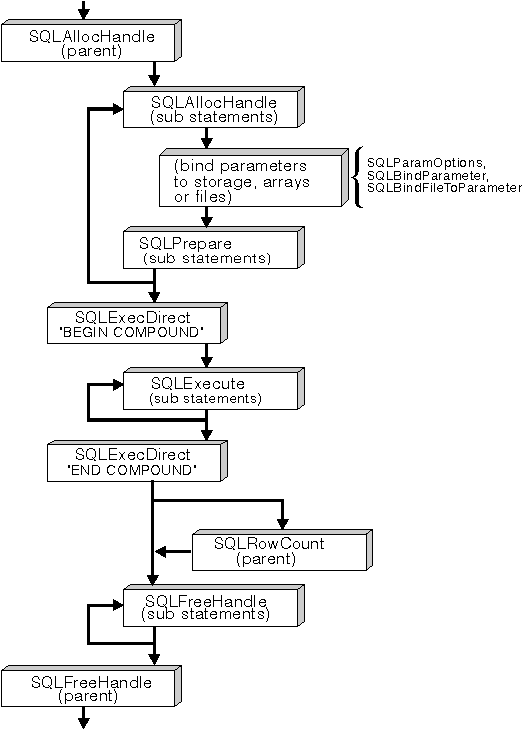
Call Level Interface Guide and Reference
A Compound SQL statement block is specified by surrounding the
sub-statements by a BEGIN COMPOUND statement and an END COMPOUND statement.
The BEGIN COMPOUND syntax is shown below:
>>-BEGIN COMPOUND--+-ATOMIC-----+-STATIC--+----------------------------------+->
+-NOT ATOMIC-+ +-STOP AFTER FIRST--?--STATEMENTS--+
>--------------------------------------------------------------><
- ATOMIC
- Specifies that, if any of the sub-statements within the Compound SQL
statement fails, then all changes made to the database by any of the
sub-statements are undone. ATOMIC is not supported in DRDA environments.
- NOT ATOMIC
- Specifies that, regardless of the failure of any sub-statements, the
Compound SQL statement will not undo any changes made to the database by the
other sub-statements.
- STATIC
- Specifies that input variables for all sub-statements retain their
original value. If the same variable is set by more than one sub-statement,
the value of that variable following the Compound SQL statement is the value
set by the last sub-statement.
- STOP AFTER FIRST ? STATEMENTS
- Specifies that only a certain number of sub-statements are to be executed.
If this clause is omitted, all the sub-statements are executed.
The END COMPOUND syntax is shown below:
>>-END COMPOUND--+--------+------------------------------------><
+-COMMIT-+
Specifying the COMMIT option will commit all the sub-statements if they
executed successfully. The COMMIT applies to the current transaction,
including statements that precede the compound statement. If COMMIT is
specified, and the connection is a coordinated distributed connection
(SQL_COORDINATED_TRANS), an error will be returned (SQLSTATE of 25000).
If the COMMIT option is not specified after END COMPOUND, the
sub-statements will not be committed unless the application is operating under
auto-commit mode, in which case the commit will be issued at the END COMPOUND.
For information on the auto-commit mode, refer to "Commit or Rollback".
Figure 15 shows the general sequence of function calls required to execute a compound
SQL statement. Note that:
- SQLPrepare() and SQLExecute() can be used in place
of SQLExecDirect().
- The BEGIN COMPOUND and END COMPOUND statements are executed with the same
statement handle.
- Each sub-statement must have its own statement handle.
- All statement handles must belong to the same connection, and have the
same isolation level.
- The sub-statements should be, but do not need to be, prepared before the
BEGIN COMPOUND statement, especially in DRDA environments where some
optimization may be possible to reduce network flow.
- The statement handles must remain allocated until the END COMPOUND
statement is executed.
- The only functions that may be called using the statement handles
allocated for the compound sub-statements are:
- SQLAllocHandle()
- SQLBindParameter()
- SQLBindFileToParam()
- SQLParamData()
- SQLPutData()
- SQLExecDirect(), SQLPrepare(),
SQLExecute()
- SQLTransact() cannot be called for the same connection, or any
connect requests between BEGIN and END COMPOUND.
- The sub-statements may be executed in any order.
- SQLRowCount() (or SQLGetSQLCA()) can be called using
the same statement handle as the BEGIN, END COMPOUND statement to get an
aggregate count of the rows affected.
Figure 15. Compound SQL
[ Top of Page | Previous Page | Next Page | Table of Contents | Index ]
[ DB2 List of Books |
Search the DB2 Books ]


